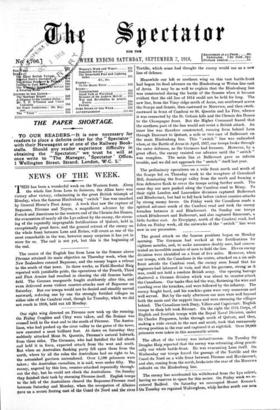The grand attack on the famous positions began on Monday
morning. The Germans had worked at the fortifications for eighteen months, and, to make assurance doubly sure, had concen- trated an incredible number of men to hold the line. Eleven enemy divisions were identified on a front of five miles. However, when our troops, with the Canadians in the centre, attacked on a six-mile front astride the Gambrel road, the enemy soon found that his engineers had laboured in vain, and that his garrison, strong as it was, could not hold a resolute British army. Our opening barrage shattered a German division which was about to counter-attack the Canadians.. Our tanks then lecrthe way, flattening the wire and crawling over the trenches, and were followed by the infantry. The enemy fought hard, and his machino-guns were very numerous and well served. But by the early afternoon our men were well beyond both the main and the support lines and were storming the villages behind. The Canadians took Dury, Villers and Cagnicourt. English troops to their left took Recourt. On the right the 17th Corps, of English and Scottish troops with the Royal Naval Division, under Sir Charles Fergusson, broke through north of Queant, and then, making a wide circuit to the east and south, took that enormously strong position in the rear and captured it at nightfall. Over 10,000 prisoners were taken in this memorable action.


























